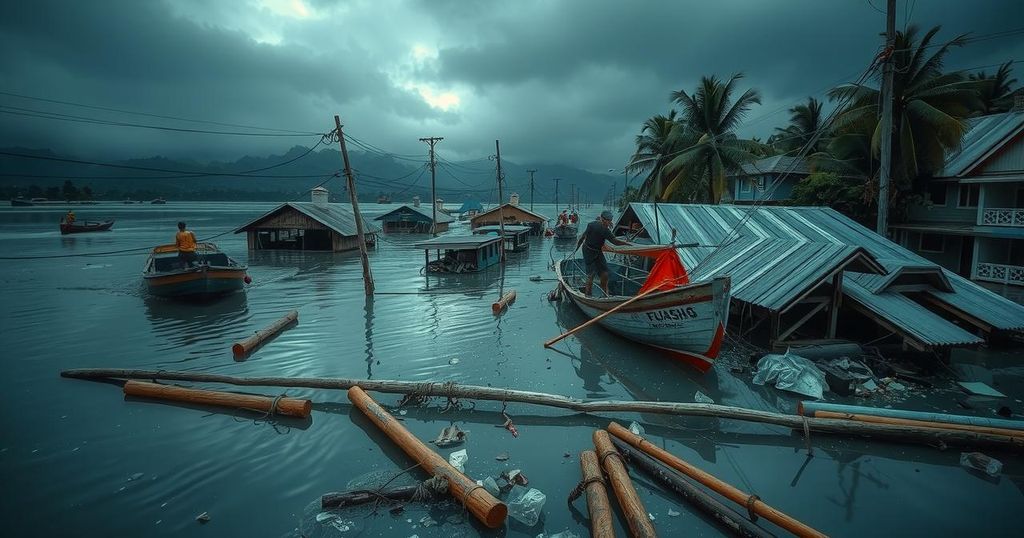Tropical Cyclone Kristine Causes Catastrophic Flooding in the Philippines
Tropical Cyclone Kristine has devastated northern Philippines, leading to more than a dozen fatalities and impacting over a million residents. Severe flooding triggered by extensive rainfall and landslides necessitated evacuation efforts. The country continues to grapple with the effects of the storm amidst ongoing rainy conditions.
A tropical cyclone named Kristine has led to catastrophic flooding in the northern regions of the Philippines, resulting in the deaths of over a dozen individuals and leaving many more missing. The National Disaster Risk Reduction and Management Council estimated that more than 1 million residents have been affected, with thousands potentially displaced due to severe landslides and relentless rainfall. Identified as Tropical Storm Trami by the Joint Typhoon Warning Center, the storm initially formed west of Guam and made landfall on Wednesday in the northern Philippines. Officials expressed concerns regarding the area’s heightened susceptibility to flash flooding, attributing it to the substantial rainfall preceding the storm along with previous cyclonic activity earlier in the month. Eyewitness accounts from the most affected regions depicted scenes of despair, with individuals navigating through waters over their chests, while local Coast Guard personnel were engaged in evacuating residents using boats. Former Vice President Maria Leonor Robredo emphasized the severity of the situation on social media, noting the stark reality that, “People have been stuck on the roofs of their houses for several hours now. Many of our rescue trucks have stalled due to the floods.” The Philippine Atmospheric, Geophysical, and Astronomical Services Administration forecasted that rainfall rates could exceed 5 inches in areas under the cyclone’s influence, with Manila, the capital and a metropolitan hub housing nearly 14 million residents, located at the southern perimeter of the moisture-laden system. Despite expectations of Kristine’s remnants gradually moving away, continued rainfall is anticipated as the region is currently under the rainy season. Historically, Manila records approximately 100 inches of precipitation yearly, transitioning to a drier season during the winter and spring months. While comprehensive assessments of damages have yet to be released following the storm, officials anticipate significant impacts with severe flooding affecting hundreds of communities across the islands. The Philippine weather service has projected the formation of 13 to 18 cyclones within its jurisdiction for the 2024 season; however, the country has already experienced 10 cyclones in the current year alone. The persistence of a “La Nada” condition in the Pacific Ocean has contributed to the ongoing climatic fluctuations, influencing global weather patterns.
The phenomenon of tropical cyclones constitutes a significant threat to countries such as the Philippines, which are situated in regions prone to extreme weather events. The islands are often affected by multiple cyclones annually, leading to devastating impacts such as flooding, landslides, and loss of life. The Philippines’s geographical position in the Pacific Ring of Fire makes it particularly vulnerable to the harsh effects of such storms, especially during the rainy season, when meteorological conditions are conducive to heavy rainfall and storm development. In the case of Cyclone Kristine, the impacts were exacerbated by the prior occurrence of storms that had already saturated the ground, making it less capable of absorbing further rainfall, thereby resulting in significant flooding. Government agencies and meteorological services continuously monitor these weather patterns to provide timely updates and aid in disaster management efforts.
In conclusion, Tropical Cyclone Kristine has wrought havoc across northern Philippines, causing substantial loss of life and property through unprecedented flooding. The storm’s effects are compounded by prior cyclonic activity and prevailing seasonal weather patterns creating an environment susceptible to disaster. As the situation unfolds, continuous assessments and effective emergency responses will be crucial in mitigating the impacts on affected residents and communities.
Original Source: www.foxweather.com




Post Comment